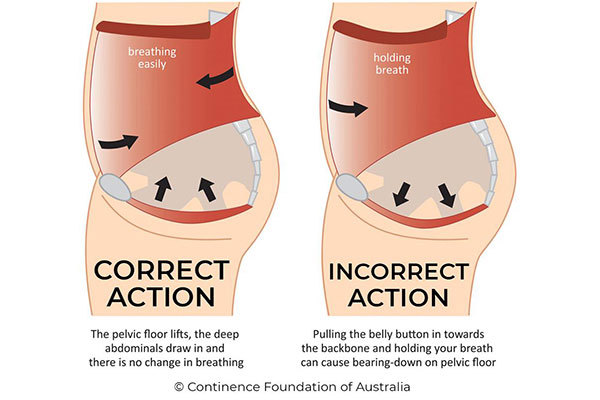The Pelvic Floor and Core
3 October 2023

The pelvic floor and core muscles work together to support the trunk when exercising, and ensuring proper firing of these muscles is essential. Read on to learn about correct pelvic floor and core activation, it’s importance during exercise, and steps you can take to improve core muscle coordination and exercise safely.
The pelvic floor muscles are a group of muscles that form a supportive sling-like structure at the base of the pelvis, helping to support the pelvic organs to maintain bowel and bladder control and normal sexual function. It works with the abdominal muscles, back muscles, and diaphragm to help support the trunk and control pressure inside the abdomen. This group of muscles if often called the ‘core’. Proper function of the core is especially important during exercise.
When we exercise, pressure inside our trunk changes. When we lift something heavy, or do a sit-up, pressure increases. Once we relax, this pressure reduces again. Regulating this pressure so that there is not increased strain on certain structures is important. For example, if we do a sit up while holding our breath, this may increase the pressures more than necessary, often putting large loads on our pelvic floor structures.
Normally, regulation of this pressure occurs automatically. The core muscles coordinate with the breath to adequately support internal structures without building excessive pressures. In the sit up example, we would ideally breathe out as we activate our abdominal and pelvic floor muscles, so that the internal pressures are relatively the same.
Where there is pain, damage, weakness or dysfunction of the core muscles, including the pelvic floor, this coordination is impaired. This is where we risk causing large increases in abdominal pressure, or inadequate support of structures when exercising. This usually results in a downward force placed on the pelvic floor and organs within it (the bladder, bowel and [in females] uterus). Over time these repeated downward forces can result in loss of bladder or bowel control, pelvic organ prolapse (‘slipping’ of the pelvic organs into the vagina, associated with sensations of bulging or dragging), and pain in the pelvic or lower back area. Pre-existing issues may be worsened. Often, people with back pain who may have impaired core muscle function also face problems with the pelvic floor, and vice versa.
Causes of pre-existing pelvic floor dysfunction may include pregnancy and childbirth, trauma or surgery, obesity, chronic constipation, chronic coughing, and aging. Issues like bladder or bowel incontinence, for example, are very common in the community, with up to 10% of Australian men and 38% of Australian women affected by urinary incontinence.Approximately half of all women who have had a baby have some degree of pelvic organ prolapse, and 1 in 5 women have one significant enough to require medical intervention.
The pelvic floor and core muscles need to be able to hold strongly, but also give way and relax. Those who brace their muscles at all times to ‘support their spine’ may have good intentions, but this can lead to tightness, discomfort, and contribute to increased internal pressure.
What can I do to improve my core muscle function?
Identifying and retraining the core and pelvic floor muscles are crucial in improving core muscle function. Once a good foundation has been established, one can layer more complicated exercises to further challenge the core and strengthen it.
At Spring, our physiotherapists can provide specialised services using Real-time Ultrasound to help clients identify, retrain and strengthen their core muscles.
Real-time Ultrasound
Real-time Ultrasound is a non-invasive, quick-to-use imaging tool that can accurately visualise the pelvic floor muscles and provide feedback to clients to train correct muscle recruitment. By isolating the pelvic floor muscles, activating in co-ordination with the deep abdominal muscles, back muscles and diaphragm, clients can effectively restore functional movement patterns and exercise their core optimally.
We have highly trained physiotherapists to help assess and manage these challenges and assist you in exercising safely and effectively.
Determine for yourself whether your pelvic floor and core muscles may need assessment and retraining using the screening tool below:
Pelvic Floor Dysfunction Screening Tool
Pelvic floor dysfunction can manifest in various ways, and its symptoms can vary from person to person. If you have any pelvic floor concerns, or relate to any of the items listed below, get in touch to book an appointment with Chris or Beeta today. We can assess your pelvic floor and core muscles using Real-Time Ultrasound, retrain them to work more effectively, and allow you to exercise safely.
- Persistent back ache
- Pelvic pain
- Sensations of pelvic heaviness or dragging
- Reduced control of bladder or bowel movements
- Difficulty with understanding how to switch on the pelvic floor muscles
- Difficulty maintaining a pelvic floor contraction without breath holding
- Resuming exercise safely following abdominal or gynaecological surgery
- Getting moving safely after giving birth
- Preparing for and/or recovering from prostate surgery
- Prior to commencing our exercise classes to have a better understanding of using the core effectively
References
Barton A, Serrao C, Thompson J, Briffa K. (2015) Transabdominal ultrasound to assess pelvic floor muscle performance during abdominal curl in exercising women.
International Urogynecology Journal. Volume 26, Issue 12, pp 1789–1795.
Continence Foundation of Australia. Key statistics about incontinence. 2023. Retrieved from https://www.continence.org.au/about-us/our-work/key-statistics-incontinence">https://www.continence.org.au/about-us/our-work/key-statistics-incontinence
Continence Foundation of Australia. Pelvic Organ Prolapse. 2022. Retrieved from https://www.continence.org.au/who-it-affects/women/prolapse
Daly, J.O., Ahern, S., Herkes, R. and O'Connell, H.E. (2019), The Australasian Pelvic Floor Procedure Registry: Not before time. Aust N Z J Obstet Gynaecol, 59: 473-476. https://doi.org/10.1111/ajo.13030">https://doi.org/10.1111/ajo.13030
Hawthorne G. Measuring Incontinence in Australia. Commonwealth of Australia; 2006.
Pelvic Floor First. Continence Foundation of Australia. Pelvic floor and core. 2022. Retrieved from https://www.pelvicfloorfirst.org.au/pages/the-pelvic-floor-and-core.html">https://www.pelvicfloorfirst.org.au/pages/the-pelvic-floor-and-core.html
Zeleke, B. M., Bell, R. J., Billah, B., & Davis, S. R. (2016). Symptomatic pelvic floor disorders in community-dwelling older Australian women. Maturitas, 85, 34–41. https://doi.org/10.1016/j.maturitas.2015.12.012




